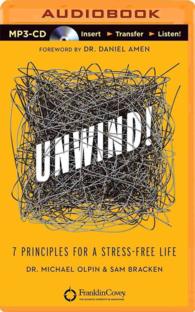Full Description
Children! Impressionable, innocent, enthusiastic, eager to learn, and all different. In fact, if you believe that all children are identical-with the same interests, abilities, and size-then Children Moving is not the book for you. The authors of Children Moving, however, recognize that each child is unique. One size does not fit all! Thus, Children Moving guides you in the process of learning to teach a curriculum that is differentiated for a range of skill abilities and fitness levels. If all children were the same, we would be able to package a curriculum with the same games and the same gymnastic stunts and dances you would do with all of the children as if they were identical. Children Moving, on the other hand, introduces you to the reflective approach-a process of teaching that provides the background for you to adapt, adjust, and modify lessons so they are interesting and worthwhile for all of the children you teach-from the lowest to the highest skill and fitness levels. The ultimate goal, of course, is to guide youngsters in the process of becoming physically active for a lifetime.The lesson plans to accompany Children Moving, On the Move: Lesson Plans for Children Moving, are now available on the CREATE platform as an ExpressBook. To order your print or eBook copies, visit http://create.mcgraw-hill.com.
Contents
PART ONE Introduction and Content OverviewCHAPTER 1 The Value and Purpose of Physical Education for Children CHAPTER 2 The Skill Theme ApproachCHAPTER 3 Skill Themes, Movement Concepts, and the National StandardsPART TWO Becoming a Reflective TeacherCHAPTER 4 Reflective TeachingCHAPTER 5 Determining Generic Levels of Skill ProficiencyCHAPTER 6 Planning and Developing the Content CHAPTER 7 Analyzing Reflective Teaching PART THREE Active Teaching Skills CHAPTER 8 Establishing an Environment for LearningCHAPTER 9 Maintaining Appropriate BehaviorCHAPTER 10 Instructional ApproachesCHAPTER 11 Observing Student ResponsesCHAPTER 12 Assessing Student Learning PART FOUR Movement Concept DevelopmentCHAPTER 13 Space AwarenessCHAPTER 14 EffortCHAPTER 15 Relationships PART FIVE Skill Theme DevelopmentCHAPTER 16 Traveling CHAPTER 17 Chasing, Fleeing, and Dodging Chapter 18Bending, Stretching, Curling, and Twisting CHAPTER 19 Jumping and LandingCHAPTER 20 BalancingCHAPTER 21Transferring Weight and RollingCHAPTER 22Kicking and PuntingCHAPTER 23Throwing and CatchingCHAPTER 24 Volleying and DribblingCHAPTER 25 Striking with Rackets and PaddlesCHAPTER 26 Striking with Long-Handled Implements PART SIX Skill Theme Movement Concept ApplicationsCHAPTER 27 Teaching Physical Fitness, Physical Activity, and WellnessCHAPTER 28 Teaching DanceCHAPTER 29 Teaching GymnasticsCHAPTER 30 Teaching GamesCHAPTER 31 Adapting the Content for Diverse LearnersCHAPTER 32 Integrating the Skill Theme Approach across the Curriculum PART SEVEN The FutureCHAPTER 33 Building Support for Your ProgramCHAPTER 34 Physical Education for Tomorrow's ChildrenAppendix Sample School-Year Overviews (Scope and Sequence)NER(01): WOW








